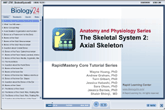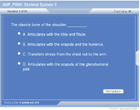| How to Learn in 24 Hours? |
|
| Need Help? |
M-F: 9am-5pm(PST):
Toll-Free: (877) RAPID-10
or 1-877-727-4310
24/7 Online Technical Support:
The Rapid Support Center
vip@rapidlearningcenter.com
Secure Online Order:

|
| Tell-A-Friend: |
Have friends taking science and math courses too? Tell them about our rapid learning system.
|
|
Skeletal System 3: Appendicular Skeleton
| Topic Review on "Title": |
Bones of the shoulder: The shoulder joint provides a connection between the chest and the arm.
- Clavicle: The clavicle, or collar bone, is a long bone that articulates with the sternum in the chest and the scapula in the shoulder. It provides a rigid support from which the scapula and arm are suspended and transfers stress, due to physical impact to the axial skeleton.
- Scapula: The scapula, or shoulder blade, is a triangular shaped flat bone that connects the humerus with the clavicle. It has a large oblong process, called the acromium.
Humerus: The humerus bone makes up the upper arm between the elbow and the shoulder. It has a large process called the head, which articulates with the scapula in the gleonhumeral joint. At the opposite end, is a medial and lateral epicondyle, where it forms the elbow joint with the bones of the forearm.
Bones of the upper extremity
- Elbow joint: The bones of the elbow include the humerus, radius and ulna. This joint is a pivot point for the forearm and plays a major role in hand movement and function.
- Humerus: The humerus has a depression called the olecranon fossa. This depression receives the olecranon of the ulna, while the forearm is extended. The olecranon forms the prominence of the elbow.
- Radius: The radius is the lateral bone of the forearm (located on the thumb side). The radial head articulates with the humerus and the radia notch of the ulna.
- Ulna: The ulna is the medial bone of the forearm (located on the little finger side), which articulates with the humerus in the elbow joint and the carpals in the wrist.
The wrist: or carpal bones, is made up of 8 small bones held together by ligaments. The carpal bones articulate with the radius and ulna and include the: The scaphoid, lunate, triquetrium, pisiform, hamate, trapezium, trapezoid and the capitate.
The hand is made up of: The hand is made up of the metacarpal bones and phalange bones. There are 5 metacarpal bones, which make up the palm. There are a total of 14 phalanges, which make up the fingers.
Bones of the pelvis: The pelvis is located at the base of the spine and contains two sockets for articulation with the lower extremities.
- Ilium: The ilium bone articulates with the sacrum at the sacroiliac joint. This joint, along with its ligaments, connects the lower extremities with the torso.
- Ischium: The ischium bone forms the lower and back part of the pelvis. The ischium bone also makes up part of the acetabulum and contains the obturator foramen.
- Pubis: The pubis bone is between the ilium and the ishium, and it forms part of the acetabulum.
Bones of the lower extremity: the leg bones are the largest bones of the body and, along with the ankle and feet, provide support for standing and walking.
- Femur: The femur, or thighbone, is the largest and strongest bone of the human body. It articulates with the hip at the hip joint and the bones of the lower leg at the knee joint.
- Tibia: The tibia is the larger of the two shinbones. It articulates with the fibula and femur at the knee joint and the tarsal bones of the ankle.
- Fibula: The fibula is the smaller shinbone; it is more posterior than the tibia. It forms the lateral portion of the ankle joint.
- The Tarsal bones are a group of bones that make up the ankle, and the foot is made up of meta-tarsal ones and phalange bones.
|
| Rapid Study Kit for "Title": |
| Flash Movie |
Flash Game |
Flash Card |
| Core Concept Tutorial |
Problem Solving Drill |
Review Cheat Sheet |
 |
 |
 |
|
| "Title" Tutorial Summary : |
This tutorial describes the bones of the appendicular skeleton, including: shoulder region, bones of the upper and lower extremities and the pelvis.
The appendicular skeleton is connected to the axial skeleton, but has its own function and role in the human body. The appendicular skeleton protects the organs of digestion, excretion and reproduction.
|
| Tutorial Features: |
Specific Tutorial Features:
Detailed pictures of the major bones of the shoulder region, upper and lower extremities, and pelvis provide the necessary learning of their anatomical location in the human body and function.
Series Features:
- Concept map showing inter-connections of new concepts in this tutorial and those previously introduced.
- Definition slides introduce terms as they are needed.
- Visual representation of concepts
- Examples given throughout to illustrate how the concepts apply.
- A concise summary is given at the conclusion of the tutorial.
|
| "Title" Topic List: |
Organization and function
Bones of the shoulder
Bones of the upper extremity
The wrist, or carpal bones, is made up of 8 small bones held together by ligaments. The carpal bones articulate with the radius and ulna and the 5 metacarpal bones of the hand.
Bones of the pelvis
|
See all 24 lessons in Anatomy and Physiology, including concept tutorials, problem drills and cheat sheets:
Teach Yourself Anatomy and Physiology Visually in 24 Hours
|



